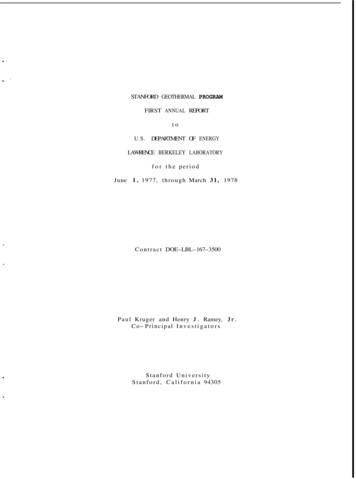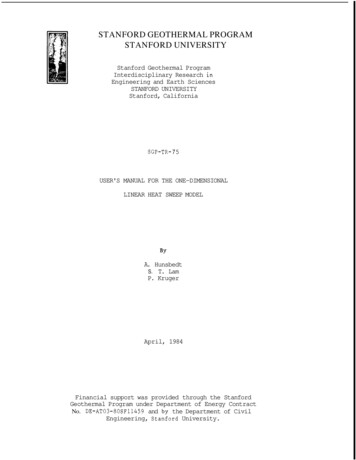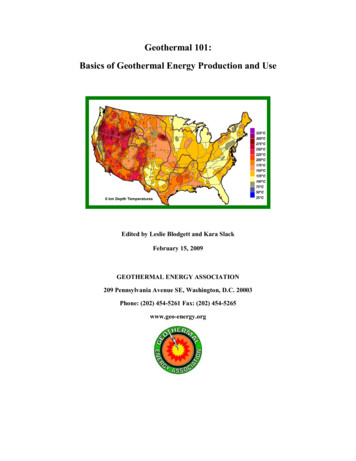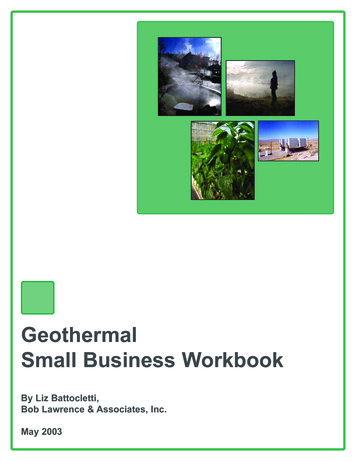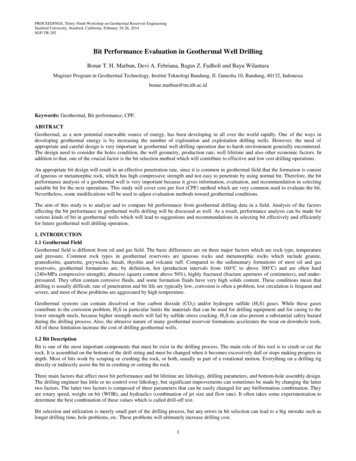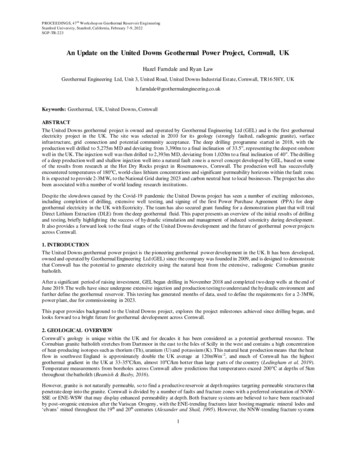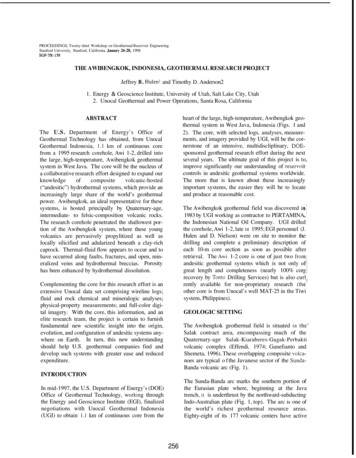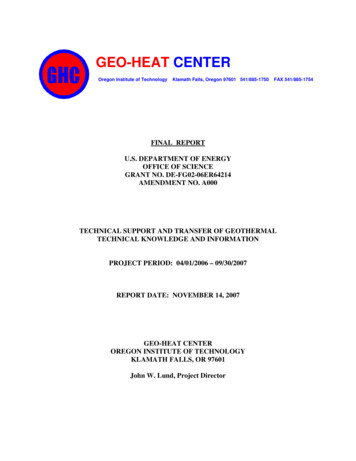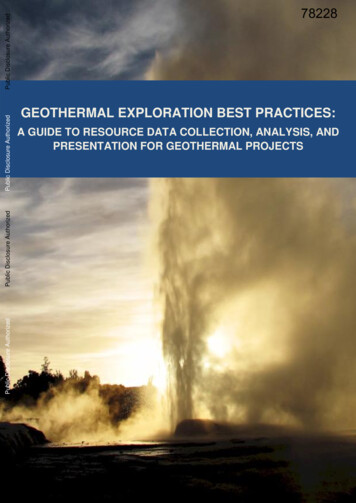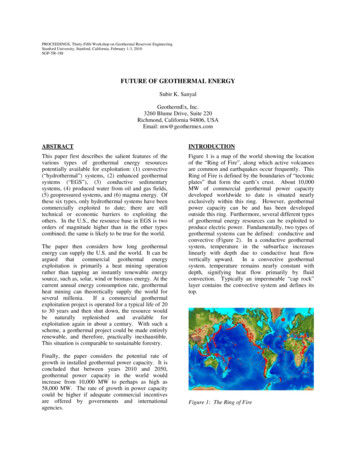
Transcription
PROCEEDINGS, Thirty-Fifth Workshop on Geothermal Reservoir EngineeringStanford University, Stanford, California, February 1-3, 2010SGP-TR-188FUTURE OF GEOTHERMAL ENERGYSubir K. SanyalGeothermEx, Inc.3260 Blume Drive, Suite 220Richmond, California 94806, USAEmail: mw@geothermex.comABSTRACTINTRODUCTIONThis paper first describes the salient features of thevarious types of geothermal energy resourcespotentially available for exploitation: (1) convective(“hydrothermal”) systems, (2) enhanced geothermalsystems (“EGS”), (3) conductive sedimentarysystems, (4) produced water from oil and gas fields,(5) geopressured systems, and (6) magma energy. Ofthese six types, only hydrothermal systems have beencommercially exploited to date; there are stilltechnical or economic barriers to exploiting theothers. In the U.S., the resource base in EGS is twoorders of magnitude higher than in the other typescombined; the same is likely to be true for the world.Figure 1 is a map of the world showing the locationof the “Ring of Fire”, along which active volcanoesare common and earthquakes occur frequently. ThisRing of Fire is defined by the boundaries of “tectonicplates” that form the earth’s crust. About 10,000MW of commercial geothermal power capacitydeveloped worldwide to date is situated nearlyexclusively within this ring. However, geothermalpower capacity can be and has been developedoutside this ring. Furthermore, several different typesof geothermal energy resources can be exploited toproduce electric power. Fundamentally, two types ofgeothermal systems can be defined: conductive andconvective (Figure 2). In a conductive geothermalsystem, temperature in the subsurface increaseslinearly with depth due to conductive heat flowvertically upward. In a convective geothermalsystem, temperature remains nearly constant withdepth, signifying heat flow primarily by fluidconvection. Typically an impermeable “cap rock”layer contains the convective system and defines itstop.The paper then considers how long geothermalenergy can supply the U.S. and the world. It can beargued that commercial geothermal energyexploitation is primarily a heat mining operationrather than tapping an instantly renewable energysource, such as, solar, wind or biomass energy. At thecurrent annual energy consumption rate, geothermalheat mining can theoretically supply the world forseveral millenia.If a commercial geothermalexploitation project is operated for a typical life of 20to 30 years and then shut down, the resource wouldbe naturally replenished and available forexploitation again in about a century. With such ascheme, a geothermal project could be made entirelyrenewable, and therefore, practically inexhaustible.This situation is comparable to sustainable forestry.Finally, the paper considers the potential rate ofgrowth in installed geothermal power capacity. It isconcluded that between years 2010 and 2050,geothermal power capacity in the world wouldincrease from 10,000 MW to perhaps as high as58,000 MW. The rate of growth in power capacitycould be higher if adequate commercial incentivesare offered by governments and internationalagencies.Figure 1: The Ring of Fire
Figure 2: A Matter of DefinitionTYPES OF GEOTHERMAL SYSTEMSSeveral different types of geothermal systems can beexploited: (a) convective (or so called hydrothermal)systems, (b) enhanced geothermal systems (“EGS”),(c) conductive sedimentary systems, (d) hot waterproduced from oil and gas fields, (e) geopressuredsystems, and (f) magma bodies.Convective hydrothermal systems have seen severaldecades of commercial exploitation for electricpower generation in about two dozen countries todate, but their distribution worldwide is limited.There are two basic classes of these convectivesystems depending on the source of the thermalenergy: volcanic and non-volcanic. A volcanicconvective system drives its thermal energy from aconvecting magma body, while a non-convectivesystem drives its thermal energy from meteoric waterthat has heated up by deep circulation in high heatflow areas of the earth; there is no magma bodyassociated with such a system. The installed powercapacity that exploits such systems totals about10,000 MW worldwide and 3,000 MW in the U.S.The reserve base in such systems in the U.S. isestimated to be in the 10,000 to 30,000 MW range(U.S.G.S., 2009).Figure 3 presents a cross-sectional view of thetemperature distribution in such a system (Beowawegeothermal field in Nevada, USA) that is nonvolcanic; this figure graphically illustrates theoccurrence of a convective “plume” of hot waterrising diagonally from depth towards the surface.Figure 3: Beowawe Geothermal Field – Initial StateTemperature Distribution (From Butler,et al, 2001)It has been suggested (Stefansson, 2005) that apositive correlation exists between the geothermalresource base potentially available from convectivesystems of the volcanic type in a country and thenumber of active volcanoes in the country (Table 1).Even if a country does not have active volcanoes, anexploitable geothermal resource base may exist in theform of non-volcanic convective systems. Forexample, Figure 4 shows the cumulative frequency ofthe number of convective geothermal systems atvarious temperature levels in the United Statesidentified in Muffler, et al, (1979). In Figure 4, thesystems hotter than 200 C are generally volcanicwhile those cooler than 200 C are non-volcanic, thelatter systems being more numerous than the former.COUNTRYNO. OF ACTIVEVOLCANOESGEOTHERMALRESOURCEBASE agua204,350NewZealand193,650Table 1: Number of Active Volcanoes in a Countryand the Geothermal Resource Base
reservoir flow capacity (“kh”) values (in millidarcyft) for a project in such a system (Sanyal and Butler,2009). Figure 5 shows that the levelized power costdecreases with increasing reservoir temperature andflow capacity, the rate of this decrease being moresensitive to reservoir flow capacity at lowertemperature levels.Figure 4: CumulativeFrequencyversusTemperature of Identified GeothermalFields in the United States (as of 1978)An enhanced geothermal system implies a man-madereservoir created by hydrofracturing impermeable orvery “tight” rock through wells. By injecting normaltemperature water in a well in such an artificiallyfractured reservoir and producing from another well,the water heated up by heat conduction from the rockit is possible to extract thermal energy. The EGSsystems represent conductive systems that have beenenhanced in their flow capacity and storage capacityby hydrofracturing. EGS can be developed, intheory, anywhere in the world by drilling deepenough to encounter a commercially attractivetemperature level. However, the EGS technology isstill experimental and poses a series of technicalchallenges, such as, (a) creating a pervasivelyfractured large rock volume, (b) securingcommercially attractive well productivity, (c)minimizing the rate of cooling of the produced waterwith time, (d) minimizing the loss of the injectedwater through fractures, and (e) minimizing anyinduced seismicity.Attempts are being made to develop geothermalprojects in sedimentary basins with high heat flow;these systems are neither EGS nor convectivesystems (due to the presence of impermeable shalelayers preventing convection). No fracturing isgenerally needed for such systems becausesedimentary rocks have intrinsic porosity andpermeability.However, wells to exploit suchsystems may have to be very deep to ensure anadequate temperature level and well productivity maynot prove adequate. No such systems have beencommercially exploited to date, but developing suchsystems should be feasible if the reservoirtemperature and flow capacity are high enough.Figure 5 shows the estimated levelized power cost in( /kWh) versus reservoir temperature for a series ofFigure 5: Levelized Energy Cost versus kh andTemperature (From Sanyal and Butler,2009)Another type of geothermal energy resource beingconsidered for exploitation today is the heatcontained in the water produced from deep oil andgas wells; the hot water may be co-produced withpetroleum or from abandoned oil or gas wells. Whilethere are no significant challenges to exploiting thisenergy resource, the cost of power from it may not bealways attractive because of the relatively lowtemperature and low production rate of the water(Sanyal and Butler, 2009).A type of geothermal energy resource of sured” systems.These are confinedsedimentary reservoirs with pressures much higherthan the local hydrostatic pressure. The high pressurein such systems may allow the exploitation of thekinetic energy of the produced water in addition to itsthermal energy. Furthermore, because of its highpressure, such a system may contain attractiveamounts of methane gas dissolved in the water; thisgas may be used to generate electric power in a gasengine. Thus an ideal geopressured well can providethermal, kinetic as well as gas-derived energy. Nocommercial geopressured project has been developedto date. There are several technical challenges tomaking this energy source commercial.
Exploitation of geothermal energy directly from amagma body is theoretically possible but faces manytechnical challenges. Moreover, the occurrence ofmagma bodies at economically drillable depths isuncommon.POTENTIALCONTRIBUTIONOFGEOTHERMAL TO THE U.S. ENERGY NEEDTable 2 lists the estimates of the geothermal resourcebase (in Joule) up to a depth of 10 km in the U.S. forthe various resource types (M.I.T., 2006). Table 2also lists the number of years of supply, at the currentU.S. energy demand level, the various types ofgeothermal resources can potentially offer.Resource TypeResource Base upto 10 km (J)No. of Yearsof PotentialReservesConvective2.4E21 to 9.6 E21 1EGS1.40E 251,400ConductiveSedimentary1.00E 2310Oil/Gas FieldWaters1.0E17 to 4.5E17 1Geopressured7.1E22 to 1.7E237 to 17Magma Energy7.40E 227Table 2:U.S. Geothermal Resource Base (M.I.T.,2006)This table clearly shows that other than EGS,geothermal resources offer a rather modest potentialfor contribution to the U.S. energy need for the longterm. Figure 6 presents a plot of the approximaterange of levelized power cost (in /kWh) versusresource base (in kJ) for each of the potentialgeothermal resource types in the U.S. Figure 6shows that oil-field (or gas-field) waters offer thecheapest source of electric power but represent a verysmall resource base, while EGS is a relativelyexpensive power source but has nearly two orders ofmagnitude higher resource base compared to all othergeothermal resource types combined. Conventionalgeothermal systems and deep sedimentarygeothermal systems, and possibly geopressuredsystems also, offer economic sources of power, butmagma energy is clearly non-commercial today. Theabove estimates assume a geothermal resource basethat is exhaustible at any given rate of exploitation.Yet, geothermal energy is considered a renewableresource. Therefore, we examine next this apparentcontradiction.Figure 6: Resource Base and Power Cost of theVarious Geothermal Energy SystemsRENEWABILITYENERGYOFGEOTHERMALThe ultimate source of geothermal energy is theextremely hot and molten core of the earth. Heatradiating out of the core is lost from the earth’ssurface, in the process giving rise to generallyincreasing temperature with depth. The energycontained in the earth’s core is so vast as to bepractically inexhaustible compared to mankind’senergy demand.Geothermal energy would beinstantly renewable if the energy extraction rate didnot exceed the natural heat loss rate from the earth’ssurface, which happens to be of the same order ofmagnitude (about 1020J per year) as the worldwideenergy consumption rate today. However, the naturalrate of heat loss per unit area of the earth’s surface(on the order of 50 kW per square km) is so low thatcommercial geothermal energy extraction is primarilya case of “heat mining”. The various types ofgeothermal energy sources considered earlier areessentially various alternative schemes of mining thisheat, each with a relatively minor contribution fromthe renewable heat flow from the earth’s core.HOW LONG CAN GEOTHERMAL ENERGYSUPPLY THE WORLD?The total amount of heat energy stored up to a depthof 5 km worldwide has been estimated at about 1.46x 1026J (Aldrich et al, 1981).A reasonableassumption is that on the order of 1% of this storedenergy is “minable”. If so, the recoverable resourcebase of geothermal energy worldwide up to a depthof 5 km is 1.46x1024J. Therefore, at the currentannual worldwide energy assumption rate of4.18x1020J, heat mining up to a depth of 5 km cantheoretically supply the world’s energy need forabout 3,500 years (Johansson, 2005). This estimate
can be considered conservative because even withtoday’s technology, drilling to a depth of at least 10km is technically feasible.Since temperatureincreases with depth, heat stored between the depthsof 5 and 10 km should be higher than that from thesurface to a depth of 5 km. Therefore, heat miningfrom the earth can theoretically supply the world atthe present level of energy demand for manymillennia. The above conclusion implicitly assumesthat the world’s energy need will not continue toincrease indefinitely. This assumption is justified bythe projection of world’s population and energydemand by various parties (for example, Figure 7),which indicate that both the population and energydemand worldwide would peak by about the year2050, after which both would start declining.the most recent energy crisis ensued and triggered afaster growth rate in geothermal capacity of 413 MWper year. The growth is likely to accelerate more inthe foreseeable future because of the increasinggrowth in power demand as well as the mountingpressure to increase the renewable energy componentof the commercial power capacity worldwide.Figure 8: Worldwide Installed Geothermal PowerCapacity (after Bertani, 2005)Figure 7: Forecast of World Population and EnergyProduction (from The Quaker Economist,Vol. 7, No. 155, March 2007)Based on the trend discussed above, one couldspeculate on the possible trends of growth ingeothermal power capacity worldwide as shown inFigure 9. The most pessimistic projection for futuregrowth rate can be considered the twenty five-yeartrend of 202 MW per year seen between 1980 and2005; with this trend, the installed capacity wouldreach about 20,000 MW by 2050. A more reasonableassumption for future growth rate may be 413 MWper year seen over the last 5 years. This assumptionGeothermal energy should be capable of supplyingthe world for a much longer period if heat mining issupplemented by exploiting the renewable aspect ofgeothermal energy. For example, if a geothermalenergy exploitation project is operated for its typicalamortization period of 30 years, and then shut down,the resource would be naturally and fully replenishedin about a century (Pritchett, 1998), at which time itcan be exploited all over again. With such anexploitation scheme, geothermal power can beconsidered truly renewable, and therefore, THERMAL POWER CAPACITYFigure 8 (after Bertani, 2005) shows the installedcapacity of geothermal power (MW) worldwide as afunction of time since 1975. As Figure 8 shows,during the “energy crisis” period of 1975 - 1980,geothermal power capacity grew at an annual rate of517 MW per year. Following the easing of theenergy crisis after 1980, the annual growth ingeothermal power capacity slowed to 202 MW peryear for the next quarter century. Then after 2005,Figure 9: Possible Growth Trends in WorldwideGeothermal Power Capacity(the “base case”) indicates the prospect of aninstalled capacity of 28,000 MW by 2050. However,it is likely that there would be continuousacceleration in the rate of growth of geothermalpower capacity over the next few decades. The
recent increase in installed capacity from 8,933 tonearly 11,000 MW between 2005 and 2010 can berepresented as an exponential growth rate of 4.25%per year. If this exponential growth rate were tocontinue over the next few decades, an installedpower capacity of 58,000 MW would be reached by2050 (Figure 9). Obviously, the rate of growth overthe next few decades can be even higher if adequatecommercial incentives are offered by governmentsand international agencies. The ultimate level of thepower capacity achievable will also depend on theextent to which the EGS technology can becommercialized, for the other types of geothermalenergy resources offer a much smaller resource baseover the long term.CONCLUSIONS1.Of the six basic types of geothermal energy, theresource base in U.S. enhanced geothermalsystems is two orders of magnitude higher thanin the other types combined; the same is likely tobe true for the world.2.Commercial geothermal energy exploitation isprimarily a heat mining operation rather thantapping an instantly renewable energy source,such as, solar, wind or biomass energy.3.At the current annual energy consumption rate,geothermal heat mining can theoretically supplythe world for several millennia.4.If a commercial geothermal exploitation projectis operated for a typical life of 30 years and thenshut down, the resource would be naturallyreplenished and available for exploitation againin about a century; with such a scheme ageothermal energy project could be madeentirely renewable, and therefore, practicallyinexhaustible.5.Between the years 2010 and 2050, geothermalpower capacity in the world would increase fromabout 11,000 MW to perhaps as high as 58,000MW.6.Rate of growth in power capacity can be higherif adequate commercial incentives are offered bygovernments and international agencies.REFERENCESAldrich, M.J., A.W. Laughlin and D.T. Gambill,1981. Geothermal Resource Base of the World:A Revision of the Electrical Power ResearchInstitute’s Estimate. Los Alamos ScientificLaboratory Report LA-8801-MS, University ofCalifornia, Los Alamos, New Mexico, April,1981.Bertani, R., 2005. World Geothermal Generation2001-2005: State of the Art, Proceedings WorldGeothermal Congress, Antalya, Turkey, 24-29April 2005.Butler, S.J., S.K., Sanyal, A. Robertson-Tait, J.W.Lovekin and D. Benoit, 2001. A Case History ofNumerical Modeling of a Fault-controlledGeothermal System at Beowawe, Nevada.Proceedings Twenty-Sixth Workshop onGeothermal Reservoir Engineering, StanfordUniversity, Stanford, California, January 29-31,2001, SGP-TR-168 pp. 35-40.Johansson, T.B. and J. Goldenberg, 2004. WorldEnergy Assessment Overview: 2004 Update.UNDP, 2005.MIT, 2006. The Future of Geothermal EnergyImpact of Enhanced Geothermal Systems (EGS)on the United States in the 21st Century. Anassessment by an MIT-Led interdisciplinarypanel. Massachusetts Institute of Technology,2006.Muffler, I.J., Editor, 1979.Assessment ofGeothermal Resources of the United States –1978, Geological Survey Circular 390. UnitedStates Department of the Interior, 1979.Pritchett, J.W., 1998. Modeling Post-AbandonmentElectrical Capacity Recovery for a Two-PhaseGeothermal Reservoir: Transactions GeothermalResources Council, Vol. 22, pp. 521-528.The Quaker Economist, 2007, Vol. 7, No. 156,March 2007.Sanyal, S.K. and S.J. Butler, 2009. Feasibility ofGeothermal Power Generation from PetroleumWells. Trans. Geothermal Resources Council,Vol. 33, pp.673-680, October, 2009.Sanyal, S.K. and S.J. Butler, 2009. GeothermalPower from Wells in Non-ConvectiveSedimentary Formations – An EngineeringEconomic Analysis. Transactions GeothermalResources Council, Vol. 33, pp. 865-870,October, 2009.Stefansson, V., 2005.World GeothermalAssessment. Proceedings World GeothermalCongress, Antalya, Turkey, 24-29 April 2005.
of geothermal energy resources can be exploited to produce electric power. Fundamentally, two types of geothermal systems can be defined: conductive and convective (Figure 2). In a conductive geothermal system, temperature in the subsurface increases linearly with depth due to conductive heat flow vertically upward. In a convective geothermal
